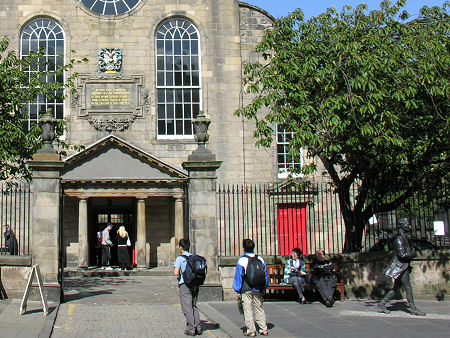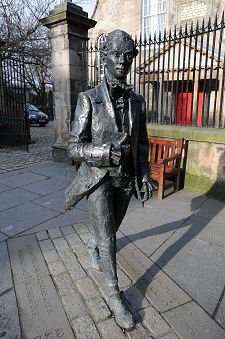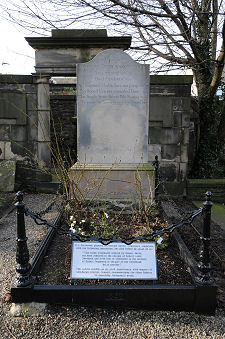 Statue of Robert Fergusson (Bottom Right of Image) Outside Edinburgh's Canongate Kirk |
Robert Fergusson lived from 5 September 1750 to 16 October 1774. He was one of Scotland's greatest poets, and the man who Robert Burns acknowledged as his inspiration. The wider picture in Scotland at the time is set out in our Historical Timeline.
Robert Fergusson was born in Cap-and-Feather Close, in Edinburgh's Old Town, the son of William Fergusson, who worked for the British Linen Company. He was educated at Edinburgh Royal High School and the High School of Dundee, before studying at the University of St Andrews. His father died in 1767 and Robert returned to Edinburgh to support his mother and sister, obtaining employment as a copying clerk in a lawyer's office.
It was while he was at St Andrews that Fergusson began to produce poetry, his first poem being a mock elegy in Scots which, at a time when most Scottish poets were using English, showed an individuality and flair matched by the poem itself. After returning to Edinburgh, Fergusson was a regular contributor of poems to "The Weekly Magazine, or Edinburgh Amusement" He was also active on Edinburgh's lively social and literary scene, becoming a member of the Edinburgh Cape Society based in a pub in the Old Town called The Isle of Man Arms. One of his poems, "Auld Reekie", was written in honour of the society and its members.
Fergusson began to suffer from severe depression in 1773, and fell prey to what at the time was called "religious melancholia". He stopped writing, withdrew completely from his friends and riotous social life, and spent his time reading the Bible. While still suffering from depression he suffered a severe injury to the head falling down a flight of stairs. His mother tried to care for him, but he was later moved to Darien House, Edinburgh's public asylum. Two months later he died, still confined in Darien House, on 16 October 1774.
His death brought to a tragically premature end a short, but highly accomplished and extremely promising literary career. Fergusson's poems were collected and published the year after his death and became an immediate success. Many of Robert Burns' poems were clearly inspired by Fergusson's work, and when Burns visited Edinburgh in 1787 he paid for the erection of a headstone in the Canongate burial ground to the man he described as "Scotia’s Poet". He also wrote the inscription, which reads:
No sculptur'd
marble here, nor pompus lay,
No story'd urn nor animated bust;
This
simple stone directs pale Scotia's way
To pour her sorrows o'er her poet's
dust.
There seems every reason to believe that had Fergusson lived, Scotland could today boats two national bards rather than just one. Robert Burns' headstone still stands over Robert Fergusson's grave, and Fergusson is also remembered in a life-size statue of him walking along the pavement just in front of Edinburgh's Canongate Kirk. The grave carries a plaque noting that Robert Louis Stevenson planned to renovate the grave, but died before he could do so. His intended additional inscription was:
This stone,
originally erected by Robert Burns,
has been repaired at the charge of
Robert Louis
Stevenson and is by him re-dedicated to the memory
of Robert
Fergusson as the gift of one Edinburgh
lad to another.


